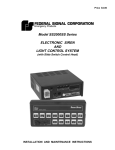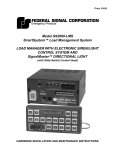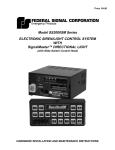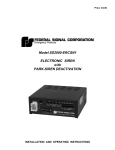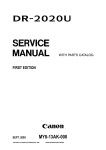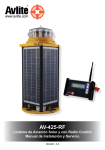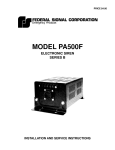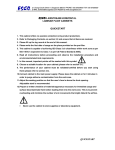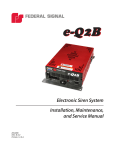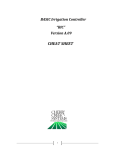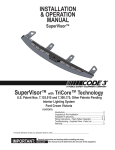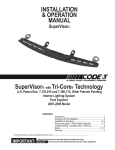Download Vision Fitness R44 Specifications
Transcript
Price $15.00 PREMIUM VISION® SL LED LIGHTBAR INSTALLATION AND MAINTENANCE INSTRUCTIONS LIMITED WARRANTY The Signal Division, Federal Signal Corporation (Federal), warrants each new product to be free from defects in material and workmanship, under normal use and service, for a period of two years on parts replacement and one year on labor from the date of delivery to the first user-purchaser. During this warranty period, the obligation of Federal is limited to repairing or replacing, as Federal may elect, any part or parts of such product which after examination by Federal discloses to be defective in material and/or workmanship. Federal will provide warranty for any unit which is delivered, transported prepaid, to the Federal factory or designated authorized warranty service center for examination and such examination reveals a defect in material and/or workmanship. This warranty does not cover travel expenses, the cost of specialized equipment for gaining access to the product, or labor charges for removal and re-installation of the product. Lamps, flash tubes, or batteries are not covered under warranty. This warranty does not extend to any unit which has been subjected to abuse, misuse, improper installation or which has been inadequately maintained, nor to units which have problems relating to service or modification at any facility other than the Federal factory or authorized warranty service centers. THERE ARE NO OTHER WARRANTIES, EXPRESSED OR IMPLIED, INCLUDING BUT NOT LIMITED TO, ANY IMPLIED WARRANTIES OF MERCHANTABILITY OR FITNESS FOR A PARTICULAR PURPOSE. IN NO EVENT SHALL FEDERAL BE LIABLE FOR ANY LOSS OF PROFITS OR ANY INDIRECT OR CONSEQUENTIAL DAMAGES ARISING OUT OF ANY SUCH DEFECT IN MATERIAL OR WORKMANSHIP. IMPORTANT WIRING CHECK LIST WARNING The Premium Vision® warning system is an advanced microprocessor based warning system. Unlike conventional light bars, malfunctions and/or improper operation WILL result if proper installation procedures are not followed. Refer to the accompanying diagram and pay special attention to the “DO & DON’T” list at the bottom of this page. To complete the electrical installation, refer to paragraph 3-7. PREMIUM VISION SL WARNING SYSTEM R - + RED + 10AWG CONTROL CABLE RJ45 (8) BLK - 10AWG CONTROL HEAD RJ11 (4) AMPLIFIER/RELAY UNIT SWITCHED IGNITION LINE CAPABLE SIREN * OF CARRYING AN ADDITIONAL 2A + BAT A 12 11 10 9 8 7 6 3 5 2 B C D 4 BLK RELAY SWITCHED POWER TO AUXILIARY DEVICES CIRCUIT BREAKER RED + 10AWG (MIN.) AUXILIARY RELAY & SIREN POWER 50 AMP 50 AMP 1 GRN RED 2 AMP VEHICLE CHASSIS FUSE BLOCK - NEG * POS + VEHICLE BATTERY CHASSIS GROUND, AT FUSIBLE LINK ON FRONT FENDER. CHECK LIST 1. Is the 10 ga. red wire from the lightbar connected to one of the two 50-ampere circuit breakers (installed as close to the battery as possible and directly to the positive (+) battery terminal)? YES 2. Is the 18 ga. red wire from the twelve pin connector (Pin 6) connected to a point on the fuse block that is powered in run and start positions? Use an in-line 2A fuse. YES 3. Is the 10 ga. black wire from the lightbar AND the 14 ga. black wire from the twelve pin Molex connector (Pin 4) connected to the fusible link at the front fender between the negative (-) battery terminal and chassis ground? This is the ONLY chassis ground allowed for these two wires. YES 4. Is the green wire from the twelve pin Molex connector (Pin 5) connected to chassis ground? YES YES AUXILIARY RELAY/SIREN POWER: 5. Is a 10 ga. wire connected to the load side of the other 50-ampere circuit breaker? Is is routed through the hole labeled +BAT on the amplifier unit and attached to LUG 1 on the circuit board? i 290A5276-01 SECTION I GENERAL DESCRIPTION The Federal Premium Vision® SL warning system is a full-featured, LED and halogen, programmable, integrated warning light and siren system. State-of-the-art microprocessor based technology is used to produce a warning system with a supercompact, 1.25” thin control head. All warning system functions are available at the Control Head. Replaceable switch function labels are provided for identification of Control Head switches. The Premium Vision also provides siren functions which include: Wail, Yelp, Hi-Lo, Priority, Air Horn, and Manual Siren. The Control Head’s center row of switches controls the siren functions. The slide switch, lower switches and upper switches control light patterns, relays and the optional SignalMaster directional light. The Control Head’s LED display indicates which lights are illuminated. When the optional SignalMaster is installed, the Control Head’s LED display simulates the light pattern being executed by the directional light. A function indicator sound (double beep) can be enabled to indicate that a function is selected. The warning system is protected against reversed polarity damage. Relay outputs are protected by automotive-type fuses. V-shaped construction lets the Premium Vision warning system maximize light warning efficiency at crucial 45° angles. The individual domes are shaped to eliminate critical dome angles, which reflect rather than transmit light in other light bars, significantly improving light transmission (brightness). The Premium Vision SL warning system may be installed in any vehicle with a 12-volt NEGATIVE ground electrical system. The Amplifier/Relay Unit may be installed in the trunk or under the seat. For simple installation: connection between the Control Head and the Amplifier/Relay Unit is via a modular telephone cable with standard modular phone connectors at both ends, and connection between the Amplifier/Relay Unit and the lightbar is via a multiconductor cable with connectors at both ends. Premium Vision’s revolutionary aerodynamic styling provides superior vehicle fuel efficiency and top speed. The LED pods are two-tier with the wide angle Solaris LEDs positioned to provide 360° coverage. The warning system’s LED pods and two Smart Pods are preprogrammed to provide a wide selection of warning light patterns. Pattern selection can be performed during or after installation. Other advanced features of the Premium Vision SL warning system include: Take-down and alley lights have horizontal tracking capability for use as spotlights. Four auxiliary relay outputs are available for control of auxiliary lights and accessories. An optional LED rear directional light, called the SignalMaster™, provides additional warning capability using a common control. The SignalMaster has pre-programmed light patterns which provide supplemental warning for any hazardous situation. 1-1 • High degree of reliability through the use of CMOS microprocessor and other integrated circuits. • Modular construction with easily replaceable circuit boards, domes and lamps to greatly reduce spare parts inventory. • Quiet, smooth, precise and efficient positioning stepper motors control parabolic reflectors and have a longer life than conventional DC motors. • High output, long-life LEDs with no moving parts. SECTION II SPECIFICATIONS 2-1. ELECTRICAL. Input Voltage.............................................................................. 11VDC to 15VDC. Polarity...................................................................................... Negative ground only. Operating Temperature Range................................................. -30°C to +65°C. Standby Current (Ignition on)................................................... 3.0 amperes (nominal). (Ignition off).................................................. 0 amperes Operating Current..................................................................... 25 amperes (nominal). (100 watt siren activated—Auxiliary functions deactivated) 2-2. SIREN. Frequency Range....................................................................... 725 to 1600Hz (nominal). Nominal Cycle Rate................................................................... Wail - 12 cycles/min. Yelp - 180 cycles/min. HI-Lo - 60 cycles/min. Nominal Siren Power................................................................. 1 100-watt speaker (10A). 2 100-watt speakers (15A). Nominal Voltage Output............................................................ 64V peak to peak (siren tones). Audio Response.......................................................................... 300Hz to 3,000Hz ±3db. Audio Power............................................................................... 45 watts in PA Mode (typical with 1.4V peak to peak input). Harmonic Distortion.................................................................. Less than 10% from 5 to 45 watts. Input Impedance (PA)................................................................ 4,000 ohms (nominal). 2-2. PHYSICAL. Dimensions: Interface/Relay Unit Height.......................................................................... Width............................................................................ Length.......................................................................... Net Weight................................................................... 2-11/16” (6.83cm). 6-3/8” (16.2cm). 6-5/8” (16.8cm). 4 lbs. (1.82kg). Control Head Height.......................................................................... Width............................................................................ Length.......................................................................... Net Weight................................................................... 3-1/8” (5.87cm). 1.25” (3.18cm). 6-3/4” (17.15cm). 9-5/8 oz. (0.273kg). Lightbar Height.......................................................................... Width............................................................................ Length.......................................................................... Net Weight................................................................... Shipping Weight......................................................................... 2-1 5-7/8” (15cm). 42” and 48” available (106.7cm and 121.9cm). 28” (71.12cm). 42 lbs. (30.45kg). 72 lbs. (32.73kg). 2-3. FEATURES SUMMARY. • V-shaped construction. • Five high output Solaris LED pods. • Two multi-function 50 watt lamp Smart pods. Rotation at 90FPM, 120FPM, and 175FPM. Oscillation to front, rear, and intersection. Alley/take-down lights with manual (sweep or single step) positioning capability. • Four auxiliary relay-controlled outputs. • User-selectable keyboard configurations with pre-programmed light patterns. • Optional rear LED SignalMaster directional light. • Unauthorized reprogramming prevention. • Rubberized control head with slide switch. • Wail and Yelp siren tones meet SAE J1849, JUL89. 2-2 SECTION III INSTALLATION SAFETY MESSAGE TO INSTALLERS OF WARNING LIGHT/SIREN SYSTEMS wiring MUST have the capacity to supply consistent warning system power at rated current and voltage levels. WARNING The lives of people depend on your safe installation and servicing of Federal products. It is important to read and follow all instructions shipped with the products. In addition, listed below are some other important safety instructions and precautions you should follow: • Never attempt to install aftermarket equipment, which connects to the vehicle wiring, without reviewing a vehicle wiring diagram - available from the vehicle manufacturer. Insure that your installation will not effect vehicle operation or mandated safety functions or circuits. Always check vehicle for proper operation after installation. • DO NOT install equipment or route wiring or cord in the deployment path of an air bag. • DO NOT install a two-way radio antenna on the lightbar. • Install the lightbar at least 18-inches away from any two-way radio antenna. • DO NOT drill additional holes in the lightbar, or install auxiliary devices on the lightbar. • When drilling into a vehicle structure, be sure that both sides of the surface are clear of anything that could be damaged. • If wiring is shorted to vehicle frame, high current conductors can cause hazardous sparks resulting in electrical fires or flying molten metal. Before Installation Qualifications • To properly install a warning light/siren system: you must have a good understanding of automotive electrical procedures and systems, along with proficiency in the installation and service of safety warning equipment. Sound Hazards • • Your hearing and the hearing of others, in or close to your emergency vehicle, could be damaged by loud sounds. This can occur from short exposures to very loud sounds, or from longer exposures to moderately loud sounds. For hearing conservation guidance, refer to federal, state, or local recommendations. OSHA Standard 1910.95 offers guidance on “Permissible Noise Exposure.” All effective sirens and horns produce loud sounds which may, in certain situations, cause permanent hearing loss. You should minimize your exposure times and wear suitable hearing protection. During Installation • DO NOT connect this system to the vehicle battery until ALL other electrical connections are made, mounting of all components is complete, and you have verified that no shorts exist. • Locate the control head so the vehicle, controls, and microphone can be operated safely. • A warning light/siren system is a high current device. In order for it to function properly, separate ground (-) and positive (+) connections must be made. They should be connected to the battery terminals. The supplied circuit breaker must be installed in the positive lead as close to the battery as practical. • After Installation The Premium Vision SL warning system is an advanced microprocessor based warning system. Unlike conventional light bars, low voltage conditions (less than 11VDC) may cause it to malfunction or fail to operate. Installation procedures MUST produce reliable and durable ground (-) and positive (+) connections. In addition: the vehicle battery, charging system, and installation • After installation, test the warning light and siren system to ensure that it is operating properly. • Test all vehicle functions, including horn operation and vehicle light systems, to ensure proper operation. Ensure that installation has not affected vehicle operation or changed any mandated safety function or circuit. • This product contains high intensity LED devices. To prevent permanent eye damage, DO NOT stare into the light beam at close range. • After testing is complete, provide a copy of these instructions to the instructional staff and all operating personnel. • File these instructions in a safe place and refer to them when maintaining and/or re- installing the product. Failure to follow all safety precautions and instructions may result in property damage, serious injury, or death to you or others. 3-1 CAUTION WARNING Excessive tightening of the Torx head screws will damage the screws. When installing equipment inside air bag equipped vehicles, the installer MUST ensure that the equipment is installed ONLY in areas recommended by the vehicle manufacturer. D. Replace the dome and secure with the previously removed Torx head screws. 3-3. LIGHTBAR INSTALLATION. Failure to observe this warning will reduce the effectiveness of the air bag, damage the air bag, or potentially damage or dislodge the equipment, causing serious injury or death to you or others. WARNING Improper warning system and/or twoway radio system operation may result if a two-way radio antenna is installed on, or within 18-inches of, the lightbar. Before permanent installation of the lightbar or a two-way radio antenna, test the warning system and two-way radio system. DO NOT install a two-way radio antenna on the lightbar. 3-1. UNPACKING. After unpacking the Premium Vision SL, examine it for damage that may have occurred in transit. If the equipment has been damaged, file a claim immediately with the carrier stating the extent of damage. Carefully check all envelopes, shipping labels and tags before removing or destroying them. Some installations may require relocation of the two-way radio antenna to a trunk or fender location. 3-2. COLORED DOME INSERT OPTION INSTALLATION (SMART PODS ONLY). WARNING Warning system failure may result if additional holes are drilled in the lightbar, or if auxiliary devices are installed on the lightbar. DO NOT drill additional holes in the lightbar, or install auxiliary devices on the lightbar. To provide proper warning colors to the front and/or rear if dome inserts are used, a clear dome must be used with the colored inserts. A. Remove and retain the two Torx head screws which secure the dome to the pod. B. Before performing any installation, see figure 3-2 (block wiring diagram); plan all wiring and cable routing. Ensure that the lightbar is installed on the vehicle roof in accordance with the instructions packed with the mounting kit. Carefully remove the dome and set it aside. C. Place the front or rear insert in position and ensure that the locating notches are properly positioned on the locating ribs as shown in figure 3-1. If applicable, repeat with the other insert. 3-4. AMPLIFIER/RELAY UNIT MOUNTING LOCATION SELECTION. CAUTION The Premium Vision SL Amplifier/Relay Unit housing is NOT waterproof. It must be mounted in a location which is sheltered from falling rain, snow, standing water, etc. Also, it must be installed in an adequately ventilated area. Never install near heater ducts. Do not mount the Premium Vision SL Amplifier/Relay Unit under the vehicle’s hood. When selecting a mounting location for the Premium Vision SL Amplifier/Relay Unit and the control head, it is necessary to keep in mind that the 290A5276-02 Figure 3-1. 3-2 290A5276-03 Figure 3-2. 3-3 control head cable is 20-feet long and the power cable is 4-feet long. Plan all wiring and cable routing before performing any installation. Some possible Amplifier/Relay Unit mounting locations are: under the dash, under the front seat, or in the trunk (under the rear deck, near the rear seat speakers, if vehicle is so equipped). Using the supplied mounting bracket will allow the Amplifier/Relay Unit to be easily removed for wiring and servicing, should it be needed. 3-5. AMPLIFIER/RELAY UNIT MOUNTING BRACKET. To install the Amplifier/Relay Unit using the mounting bracket, proceed as follows: A. Use the mounting bracket as a template and scribe two drill positioning marks at the selected mounting location. CAUTION 290A5276-04 Figure 3-3. Before drilling holes in ANY part of a vehicle, be sure that both sides of the mounting surface are clear of parts that could be damaged; such as brake lines, fuel lines, electrical wiring or other vital parts. To mount the control head using the bracket, proceed as follows: A. Assemble a bracket to the control head using the 6-32 x 1/4 screws and #6 lockwashers. Assemble the other bracket to the control head/bracket assembly using the 1/4-20 x 3/4 hex head screws and 1/4” lockwashers as shown in figure 3-5. NOTE If desired, the #14 thread-forming screws may be used in place of the 1/4-20 x 3/4 hex head screws. B. marks. NOTE Drill two mounting holes at the position The brackets are not symmetrical. After assembling the brackets to the control head, ensure that the assembly can be properly positioned at the intended mounting location. If proper positioning cannot be achieved, reverse thebracket. C. Secure the mounting bracket to the mounting surface with (2 each) 1/4-20 x 3/4 hex head screws, 1/4 split lockwashers and 1/4-20 hex nuts as shown in figure 3-3. 3-6. CONTROL HEAD INSTALLATION. B. Use the mounting bracket as a template and scribe two drill positioning marks at the selected mounting location. CAUTION Unreliable switch activation and loss of “tactile feedback” will result if the control head mounting method allows movement. DO NOT mount the control head on padded surfaces. CONTROL HEAD NOTE: USE ONE OF THE THREE SETS OF HOLES. THIS ALLOWS UP/DOWN CONTROL POSITION OF THE PIVOT BRACKET. Choose a firm and flat mounting location for the control head that allows the vehicle, controls, and microphone to be operated safely at all times. #6 SPLIT LOCKWASHER (2) #6-32 x 1/4" SCREW, PHL. PAN HD (2) See figure 3-4. The supplied hinged mounting bracket enables the control head to be mounted in a variety of positions. Positioning the bracket above the unit allows mounting the control head on the underside of the dash. Positioning the bracket below the unit will permit mounting on any horizontal surface. PEM-NUT (ATTACHED TO BRACKET) 290A5276-05 BRACKET (1 OF 2) Figure 3-4. 3-4 PREVIOUSLY ASSEMBLED CONTROL HEAD AND BRACKET 1. Route the lightbar power cable and the control cable into the vehicle. PEM-NUTS (ATTACHED TO BRACKETS) 1/4" LOCKWASHER, EXT. TOOTH (2) 2. Route the control cable near the location of the previously installed Amplifier/Relay Unit and secure the cable with user-supplied clamps and hold-downs as required. 1/4-20 x 3/4" SCREW, HEX HD. (2) #10 SCREWS, THD. FORM. (2) 3. Plug the control cable’s connector into the mating connector on the Amplifier/Relay Unit. MOUNTING HOLES FOR #10 SCREWS CAUTION Before drilling holes in ANY part of a vehicle, be sure that both sides of the mounting surface are clear of parts that could be damaged; such as brake lines, fuel lines, electrical wiring or other vital parts. MOUNTING SURFACE BRACKET (2 OF 2) PILOT HOLES (2) 290A5276-06 Figure 3-5. CAUTION 4. If necessary, drill a hole in the vehicle firewall. Place a grommet or similar device in the hole to protect the wires against damage from rough edges. Route the power cable into the engine compartment. Before drilling holes in ANY part of a vehicle, be sure that both sides of the mounting surface are clear of parts that could be damaged; such as brake lines, fuel lines, electrical wiring or other vital parts. C. marks. To protect the wire, a separate circuit breaker must be connected as close as practical to the positive (+) battery terminal. See figures 3-2 and 3-6. Install the supplied two 50-ampere circuit breakers (Federal Part No. 8474176). DO NOT remove the jumper on the battery side of the circuit breakers. Connect the red wire to one of the 50-ampere circuit breakers. Drill two mounting holes at the position D. Secure the mounting bracket to the mounting surface with the #10 thread-forming screws as shown in figure 3-5. 3-7. ELECTRICAL INSTALLATION. Do NOT make any connections to the battery until all other wiring is complete. WARNING Failure to observe this WARNING may result in fire, burns or blindness. B. If shorted to vehicle frame, high current conductors can cause hazardous sparks resulting in electrical fires or molten metal. Amplifier/Relay Unit Power Cable Connections. The Amplifier/Relay Unit power cable, included in the carton, is equipped with a twelve-pin plug that mates with the connector on the rear of the Amplifier/Relay Unit (see figures 3-7 and 3-8). Additional wire (the same gauge or heavier) may be DO NOT connect this system to vehicle battery until ALL other electrical connections are made and mounting of all components is complete. Verify that no short circuits exist, before connecting to the Positive (+) battery terminal. To complete this portion of the installation, proceed as follows: A. Lightbar Connections. The lightbar is completely wired at the factory and does not require any additional internal wiring. All the conductors necessary for control of all functions are contained in the cables. 290A5276-07 Figure 3-6. 3-5 A speaker is not included as part of this warning system. FEDERAL speakers are weatherproof and may be installed in any convenient location; on the roof, fender, behind the grill, etc. Any special mounting instructions applicable to the type of speaker you have selected will be found in the speaker carton. Connect the speaker leads (18 gauge wire) as shown in figure 3-8. 290A5276-08 spliced to the leads as required. A block wiring diagram is shown in figure 3-2. The various wires on the connector must be connected as follows: NOTE Use electrical tape to insulate ANY unused power cable wires. 1. The unit is designed to operate with one 11-ohm impedance speaker or two 11 ohm impedance speakers connected in parallel and in phase. On Federal speakers, this can be accomplished by connecting the two speaker leads marked “1” to the SPEAKER COMMON power cable lead and the two speaker leads marked “2” to the SPEAKER HI power cable leads. See figure 3-8. 10 7 11 8 12 9 4 5 6 1 2 3 HORN RING IGNITION, FUSE BLOCK GRN BLU RED WIRE The horn ring transfer circuit of the siren is capable of switching a maximum of 2-amperes. Some vehicles do not have a horn relay and, consequently, will draw more than 2-amperes when the vehicle horn is activated. Consult your vehicle service manual or a qualified mechanic to determine the current required to activate the horn. If it is less than 2-amperes, perform the procedure in step c. If it is greater than 2-amperes, perform steps d through j. COMMON MIC. WHT/YEL RED 2AMP ORN CAUTION VEHICLE TWO-WAY RADIO SPEAKER VIO BLK BRN b. See figure 3-9. Splice the white/ yellow power cable wire to the horn ring side of the wire that was cut in step a. Insulate the splice with the wire nuts (supplied). PURSUIT SWITCH BRN BRN CHASSIS GROUND (NEG.) (–) AT FUSIBLE LINK SPEAKER, HI POWER (100W) N.C. NOT USED SPEAKER, COMMON 1. SLIP MALE CLIP OVER THE FUSE. MALE CLIP c. Splice the white power cable wire to the horn side of the cut wire. Insulate the splice with a wire nut. 2. INSERT CLIP AND FUSE INTO FUSE BLOCK. FEMALE CLIP Horn Ring. a. Locate the wire that connects the vehicle horn ring switch to the horn or horn relay. Cut this wire. HORN GRA 3. In order to utilize the horn ring control of siren tones (Tap II) and other features of the warning system, the following procedure must be performed. Speaker. WHT Radio. See figure 3-8. To allow incoming radio messages to be rebroadcast over the outside speakers, connect the two brown zip cord leads (twelve-pin connector, pins 9 and 12) across the two-way radio’s speaker. Figure 3-7. 2. 3. ATTACH THE RED WIRE WITH FEMALE CLIP. FUSE TOP OF FUSE BLOCK 290A5276-10 290A5276-09 Figure 3-9. Figure 3-8. 3-6 d. Obtain a SPST relay of sufficient contact current capacity to activate the vehicle horn. Refer to figure 3-9 while performing the following steps. location. e. Mount the relay in a suitable When switch 10 is activated, GROUND is supplied on the power cable’s violet wire. This GROUND circuit is capable of handling 200 milliamperes or less, which should be adequate for most automotive relays. g. Determine the “sense” of the vehicle’s horn ring activation circuit, i.e., does the horn circuit require a switched positive voltage or switched ground for activation. A 40-amp. relay (Federal Signal Part No. 131A175) is recommended. Figure 3-10 shows the wiring for any single pole relay. The pin numbers shown are for the recommended Federal Signal relay. h. Connect the relay wiper terminal to the positive or negative potential determined in step g. 7. i. Connect the white power cable wire to one end of the relay coil. Park-Siren Deactivator. NOTE Transient noise pulses caused by the automotive power system or surge currents due to switching inductive or incandescent lamp loads may cause malfunctions in the Premium Vision SL if proper wire routing is not followed. IMPORTANT It is the installer’s responsibility to determine an appropriate location in the vehicle circuitry to connect the pursuit wire. This feature uses the pursuit wire to automatically deactivate siren tones when the vehicle is shifted into PARK. The Amplifier/Relay Unit red (positive) power cable lead should be as short and direct to the fuse block or user-supplied switch (current capacity of at least 2 amps) as possible. DO NOT splice to lightbar or accessory power leads. See figure 3-8. To use this feature, connect the power cable’s gray wire to a vehicle circuit that is grounded when the vehicle is shifted into PARK. 5. Connection to Power Source (see figure 3-8). The Premium Vision SL must operate from a 12 volt NEGATIVE ground vehicle electrical system. Therefore, before making any electrical connections, verify the polarity of the vehicle electrical system ground. j. Connect the other end of the relay coil to the opposite potential of that connected to the wiper in step h. 4. External Auxiliary Relay. When switch 10 of the control head is not used for the common microphone function, it can be used to activate an external relay. Switch 10 can function only in a push-on/push-off mode. f. Connect the horn side of the wire cut in step a to the relay contact terminal. 6. The Amplifier/Relay Unit black (negative) power cable lead should be as short and direct to the fusible link on the front fender as possible. DO NOT splice to lightbar or accessory negative (black) leads. Common Microphone. a. If the PA and RADIO transmitter are to share a common microphone, the audio switching must be performed by a user-supplied switching device. The violet wire provides a ground when the Premium Vision SL is operating in the PA mode. The black (negative) power cable lead MUST be connected to the vehicle chassis ONLY at the fusible link on the front fender. Refer to the instructions provided with the switching device. Connect the GROUND ACTIVATED (200 milliamperes or less) switching device to the violet wire. VIOLET WIRE FROM POWER CABLE, PIN 8 +12VDC b. If the PA and RADIO transmitter are to have separate microphones, fold back and insulate the violet wire. +12VDC 85 30 86 87 AUXILIARY DEVICE 290A5276-11 Figure 3-10. 3-7 IMPORTANT The Premium Vision SL system does not have an on-off switch. If Amplifier/Relay Unit power is obtained directly from the vehicle battery, the system will continuously draw approximately 3.0A and will eventually discharge the vehicle’s battery. It is RECOMMENDED that Amplifier/Relay Unit power be obtained from a vehicle circuit that is powered RUN, and START positions. Power can also be obtained from a user-supplied switch (current capacity of at least 2 amps). Siren/Auxiliary Connections. IMPORTANT Steps 1, 2, 3, 4, and 6 below ARE REQUIRED FOR SIREN FUNCTIONS whether or not the auxiliary relays are used. The total relay current plus the siren current MUST NOT EXCEED 50-amperes. The Premium Vision SL relay-controlled outputs can control auxiliary lights and accessories. Specific control head switches operate the relay-controlled outputs. To properly connect the auxiliary devices to the warning system, it is necessary for the installer to understand which control head switch(es) activate the output(s). The Premium Vision SL is configured at the factory to satisfy most installation requirements. CAUTION Before drilling holes in ANY part of a vehicle, ensure that both sides of the surface are clear of parts that could be damaged; such as brake lines, fuel lines, electrical wiring or other vital parts. a. Connect the green power cable lead to the vehicle chassis as close as practical to the Amplifier/Relay Unit. Scrape paint away from the selected bolt hole to assure a good electrical connection to the chassis. Before proceeding with installation, refer to the supplied Operation and Configuration Instructions manual for a description of the “standard” keyboard configuration and for instructions on how to change the configuration (if necessary). b. Power for the Amplifier/Relay Unit can be obtained from the vehicle’s fuse block; or a 2-ampere fused, switched circuit. When obtaining power from the vehicle’s fuse block, refer to the vehicle’s wiring manual to ensure the unit will be powered in the RUN and START positions. The Premium Vision SL provides one terminal strip (TB1) for control of auxiliary lights and accessories. A total of four fused relay-controlled outputs are available. Each relay-controlled output is fused at 20-amperes. Route the red (+) power cable lead to the fuse block or user-supplied switch. When the red (+) power cable lead is routed to the fuse block, install the supplied fuse clip adapter as follows (see figure 3-8): over the fuse. C. Each output switches a nominal +12-volts to the controlled device. Do NOT use the black wire in the Amplifier/Relay Unit power cable for grounding the switched device(s). Ground the switched devices separately. (1). Slip the fuse clip adapter NOTE Output D provides both normally open/normally closed (NO/NC) and common contacts (C). By removing the fuse labeled “F5”, Output D can be isolated from the +12-volt battery supply for switching other POSITIVE voltages (connected to Output D’s terminal labeled “C”). (2). Insert the adapter clip/fuse into the applicable fuse block location with the adapter clip end toward the top of the fuse block. (3). Attach the power cable’s red wire on the fuse clip. c. To protect the wires, use an inline fuseholder and 2-ampere fuse (not supplied). The fuseholder and fuse should be installed in the red (+) lead as close as practical to the power source. Refer to the installation instructions provided with the auxiliary devices for additional precautions and details. Complete the siren wiring and wiring to the accessories (if any) as follows: d. Route the black (-) power cable lead through the previously drilled hole into the engine compartment, and through existing clamps and holders toward the fusible link on the front fender. DO NOT make any connections to the battery until all other wiring is complete. 1. Remove the chassis cover by loosening the 2 screws on the bottom of the Amplifier/Relay Unit. Slide the cover to expose the terminal strip. 3-8 2. Route a #10AWG or larger (depending on accessory loads) red wire through the hole labeled +BAT. Attach it to the large lug-type terminal (LUG1) on the circuit board (see figure 3-11). Since this wire provides the power source for the siren and all relay-switched auxiliary functions, a good mechanical and electrical connection here is important. Also, ensure that there are no loose wire strands which may cause a short circuit. 3. Route this wire through the previously drilled hole into the engine compartment and through existing clamps and holders toward the battery. 290A5276-12 4. To protect the wire, the Premium Vision SL, and the auxiliary outputs, connect it to the UNUSED LOAD SIDE of the previously installed 50-ampere circuit breakers. DO NOT make any connections to the battery until all wiring is complete. Figure 3-11. 2. Insert the modular connector in the mating receptacle on the back of the Amplifier/Relay Unit. Secure with user-supplied clamps and/or wire ties to provide strain relief. NOTE 3. Insert the other modular connector in the receptacle on the control head. Secure with usersupplied clamps and/or wire ties to provide strain relief. Step 3-7.C.5. below is necessary ONLY if auxiliary devices are to be controlled by the warning system. 5. See figures 3-7 and 3-11. Connect wires from the accessories to TB1 as applicable. Refer to the instructions packed with the accessories for proper wire gauge, current requirements, and any additional instructions. D. Microphone Connections. The Premium Vision SL is not supplied with a microphone. A Federal Model MNCT-SB microphone may be plugged into the microphone jack on the rear of the Amplifier/Relay Unit. 6. Replace the chassis cover. Slide it forward and secure with the two screws. E. If the Amplifier/Relay Unit is remotely mounted, Model RMK (microphone extension kit) is available from Federal. It includes a 20-foot extension cable with phone plug, jack, and dashboard mounting bracket. Control Head Connections. All connections between the Premium Vision SL control head and Amplifier/Relay Unit are accomplished by a single 20-foot telephone-type cable (provided). It is terminated with modular-type connectors on each end. Carefully route the extension cable through the vehicle along with the telephone-type cable, and secure with user-supplied clamps and ties as required. CAUTION The unit will not operate if the telephone-type cable is improperly wired. If it is necessary to shorten the 4 conductor telephone-type cable, ensure that the connections made to the modular connector are exactly the same as the original cable connections. 3-8. INSPECTION AND FINAL INSTALLATION. A. See figure 3-3. Secure the Amplifier/Relay Unit to the mounting bracket with the BLACK 1/4-20 x 7/16 hex head screws and 1/4 split lockwashers. Ensure all fasteners are properly tightened. To complete this portion of the installation, proceed as follows: B. Before connection to the power source, perform a visual check of all connections and wiring. 1. Route the 20-foot cable between the control head and the Amplifier/Relay Unit. Secure the cable with user-supplied clamps and hold downs as required. C. Ensure that there are no loose wire strands or other bare wire which may cause a short circuit. Also, all wires must be protected from any sharp 3-9 edges which could eventually cut through the insulation. D. Use an ohmmeter to verify that a short circuit does NOT exist between the positive (+) and negative (-) power cable leads. Also, there must be NO short circuits between the positive (+) wires and the vehicle chassis. WARNING Failure to observe this warning WILL result in severe instantaneous damage to the Premium Vision SL system. 290A5276-13 The reverse polarity protection WILL NOT protect against red (+) and black (-) wires mixed in the same connection. Ensure that all positive (red) and negative (black) wires are properly connected together (reds to reds, and blacks to blacks) before connecting to the power source. Figure 3-12. Select the appropriate labels from the supplied sheet of function legends. Peel the labels from the sheet and apply to the key pad in the area provided as shown in figure 3-12. Verify that the label is properly tucked under the retaining ridge on the pushbutton. E. See figure 3-6. After performing steps A through D, connect all black (-) wires to the fusible link on the front fender. Secure mechanical and electrical connections are required. 3-10. TESTING AFTER INSTALLATION. NOTE The Premium Vision SL warning system is supplied with the Default Configuration selected. F. See figure 3-6. Connect a user-supplied #8AWG or larger red wire between the circuit breakers and the battery as shown. Again, secure mechanical and electrical connections are required. Before testing, read and understand Section I Operation in the supplied Operation and Configuration Instructions. After installation is complete, test all warning system functions to ensure that all functions and controlled devices operate as intended. Test all vehicle functions, including horn operation and vehicle light systems, to ensure proper operation. 3-9. REPLACEABLE FUNCTION LABELS. See figure 3-12. Replaceable function labels identify the switches on the control head. A sheet of applicable function legends is supplied. Configuration is described in Section II Configuration in the supplied Operation and Configuration Instructions. To install the function legends, proceed as follows: 3-10 SECTION IV OPERATION SAFETY MESSAGE TO OPERATORS OF FEDERAL SIGNAL WARNING SYSTEMS Signaling Limitations WARNING The lives of people depend on your safe operation of Federal products. It is important to read and follow all instructions shipped with the products. In addition, listed below are some other important safety instructions and precautions you should follow: • Be aware that the use of your visual and audible signaling devices does not give you the right to force your way through traffic. Your emergency lights, siren, and actions are REQUESTING the right-of-way. • Although your warning system is operating properly, it may not alert everyone. People may not hear, see, or heed your warning signal. You must recognize this fact and continue driving cautiously. • Situations may occur which obstruct your warning signal when natural or man-made objects are between your vehicle and others, such as when you raise your hood or trunk lid. If these situations occur, be especially careful. • The control head’s LED display simulates the light pattern(s) being executed by the warning system. The display is intended ONLY as a guide and NOT as an indication of proper warning system operation. Before using the warning system, its operation should be observed from outside the vehicle. Qualifications • To properly use a light system: you must have a good understanding of general vehicle operation, a high proficiency in the use of safety warning equipment, and thorough knowledge of state and federal UNIFORM TRAFFIC CODES. Sound /Light Hazards • Your hearing and the hearing of others, in or close to your emergency vehicle, could be damaged by loud sounds. This can occur from short exposures to very loud sounds, or from longer exposures to moderately loud sounds. For hearing conservation guidance, refer to federal, state, or local recommendations. OSHA Standard 1910.95 offers guidance on “Permissible Noise Exposure.” • All effective sirens and horns produce loud sounds which may, in certain situations, cause permanent hearing loss. You should minimize your exposure times and wear suitable hearing protection. • This product contains high intensity LED devices. To prevent permanent eye damage, DO NOT stare into the light beam at close range. Driving Limitations • At the start of your shift, you should ensure that the warning system is securely attached to the vehicle and operating properly. • If the unique combination of emergency vehicle equipment installed in your vehicle has resulted in the light/siren controls being installed in a position that does not allow you to operate them by touch only, OPERATE CONTROLS ONLY WHILE YOUR VEHICLE IS STOPPED. • If driving conditions require your full attention, you should avoid operating the light/siren controls while the vehicle is in motion. Sound Limitations • • Maximum sound output will be severely reduced if any objects are in front of the speaker. If your installation has obstructions in front of the speaker, drive even more cautiously. Continuing Education • Frequently inspect the speaker to ensure that it is clear of any obstruction, such as mud or snow, which will reduce maximum sound output. File these instructions in a safe place and refer to them periodically. Give a copy of these instructions to new recruits and trainees. Failure to follow these safety precautions may result in property damage, serious injury, or death to you, to passengers, or to others. 4-1 IMPORTANT control head switch is recessed and aids guiding the operator’s finger to the switch’s center for activation. When a switch is pressed, “tactile feedback” provides function selection indication as follows: a click is felt, a beep is heard, the selected function’s LED is illuminated, and the control head’s V-shaped LED display indicates which warning system lights are illuminated. If the optional SignalMaster directional light is installed, the control head display simulates the directional light pattern being executed. System configuration and any changes to the “standard” keyboard configurations (if any) MUST be provided to the operator by the installer or person responsible for programming. It is the operator’s responsibility to understand how his particular system is configured (programmed) to operate. OPERATING INSTRUCTIONS Specific operating instructions are provided in the supplied Operation and Configuration Instructions. The Premium Vision SL control head is designed to assist the operator’s selection of functions. Each 4-2 SECTION V CONFIGURATION Three default patterns are assigned to operate in slide switch positions 1, 2, and 3. They are as follows: WARNING Property damage, serious injury, or death to you or others may result if the Vision warning system is improperly configured. Configuration, if required, is to be performed at the time of installation. It is NOT intended for operators to “customize” the Vision’s operation for their individual preferences. It is the USER’s responsibility to determine compatibility, suitability, and ensure proper configuration of the Vision warning system. • • • Slide Switch Position #1 – Single flash Slide Switch Position #2 – Quad flash Slide Switch Position #3 – Random To change a flash pattern assigned to a slide switch perform the following: A. Remove POD #1 dome. B. Activate the lightbar in the desired slide switch position. The bar will flash in the current pattern. The person responsible for configuration MUST be familiar with local codes and procedures for safe emergency vehicle warning system operation. C. Depress the white momentary switch. The LED flash pattern will advance to the next available pattern and the end LED module in POD #1 will flash the pattern number. The lightbar will stop momentarily, then operate in the selected pattern. Each time the white pushbutton is depressed the pattern number will advance. When the last available pattern number is reached the next operation of the switch will select the first available pattern. CONFIGURATION INSTRUCTIONS The Premium Vision is an extremely versatile and configurable warning system. Take-down lights, alley lights, secondary and primary warning light patterns, siren functions, and the optional SignalMaster directional warning signals are all available with the “standard” keyboard configurations. Also, control of auxiliary devices (headlight flashers, grille lights, etc.) is available. For configuration instructions, refer to the supplied Operation and Configuration Instructions. D. If patterns assigned to the other slide switch positions are to be changed, position the slide switch to the desired position and repeat the above steps. 5-1. USER FIELD-PROGRAMMABLE FUNCTIONS. E. Reinstall POD #1 dome. See figure 5-1. There are three lightbar functions that can be programmed by the user, via two switches located in POD 1. The red ON/OFF switch is ON when the pushbutton is in, OFF when the pushbutton is out. MOMENTARY SWITCH 5-2. LED FLASH PATTERNS. There are six available LED flash patterns: • Random • Quad Flash alternating 75FPM • Single Flash alternating 75FPM • Alternate Flash POD’s 1&7 90FPM rear only • Alternate Flash POD’s 1&7 90FPM front and rear • Alternate Flash POD’s 1&7 with POD 4 90FPM rear only RED ON/OFF SWITCH 290A5276-14 Figure 5-1. 5-1 To assign a different Smart Pod program input to a slide switch perform the following: 5-3. SMART POD PATTERNS. There are three Smart Pod program inputs plus an OFF position that can be assigned to a slide switch position. 1. 2. 3. 4. A. Disconnect power to the lightbar. If the lightbar cover is off, this can easily be accomplished by removing either one of the 10GA red wires from the relay. OFF P1 P2 P3 The Smart Pods are programmable on two levels. First, each of the program inputs, i.e., P1, P2, and P3, can be set to do one of eight available patterns. See figure 5-2. These patterns are selected using dip switches located on the Smart Pod Controller board. Refer to tables 1 through 3 shown below. See Section VI Service and Maintenance for board access procedures. Once patterns are chosen for each of the program inputs, then the program inputs are assigned to a slide switch position. BATT- BATT+ Q2 H1 Q3 Q4 C1 1 J1 H2 R22 R30 R23 R31 L2 L3 L4 L1 R24 R32 L5 Q11 R38 Q10 C20 U5 C23 C24 R43 R42 R46 L6 R47 R45 R44 L7 R48 L8 R49 L9 C21 J4 8 1 S1 2. Slide switch #2 – Front LED module POD #1,the upper LED module POD #1, and the Smart Pods will operate according to the stored program input. D8 R51 C25 C26 D7 R35 C16 D10 D9 - 3. Slide switch #3 - All three LED modules in POD #1, and the Smart Pods will operate according to the stored program input. F3 J6 R10 U4 U2 R34 C15 RN1 1 U6 C19 + R25 D11 RN2 1 R26 R27 R36 D3 C17 Q6 R40 D2 Q5 R39 S2 R28 R37 C18 D5 P1A P1B P1C P2A P2B P2C G. Depress the white momentary switch and the Smart Pods will advance to the next program input. Each time the white pushbutton is depressed the program number will advance. When the last available program number is reached the next operation of the switch will select the first available program, which is OFF. D6 2005325A- R52 1 2 R53 FEDERAL SIGNAL CORP. UNIVERSITY PARK,IL H. If programs assigned to the other slide switch positions are to be changed, move the slide switch to the desired position and repeat the above steps. 6 WL TD 1/2 P3C P3B P3A O N 1 Switch the red ON/OFF pushbutton to ON. C11 C13 Y1 R50 U7 F2 U3 R12 U1 C22 R41 J5 R9 R11 R33 + Q9 C12 1 + Q8 J3 C10 C14 D4 Q7 7 R13 R14R15 R16 R17 R18 R19 R20 D1 C2 C3 C4 C5 C6C7 R21 R29 + J2 R1 R2 R3 R4 R5 R6 R7 R8 TD C8 WL 1 Q1 1 F1 F4 1/2 P3C C9 P3B P3A 1 J8 C. 1. Slide switch #1 – Front LED module POD #1 and the Smart Pods will operate according to the stored program input. Slide switch position #3 – P2, Rotate 90 8 F. Move the slide switch to the desired position. The following will illuminate for each slide switch position. Slide switch position #2 – P2, Rotate 90 10 Remove POD #1 dome. E. The right upper LED module in POD #4 will light indicating the bar is in Smart Pod programming mode. Slide switch position #1 – P1, Rear Flash- J7 B. D. Apply power to the lightbar. The switch must be in the ON position when power is applied to the lightbar. The default program inputs assigned to each slide switch position, along with the default pattern for each program input are as follows: • ing • FPM • FPM 6 POS SWITCH S1 S2 P1A P1B P1C P2A P2B P2C I. Switch the red ON/OFF pushbutton to OFF. J. Remove power from lightbar and wait 30 seconds and re-apply power to lightbar. Check for proper operation of lightbar. If lightbar does not function the red ON/OFF pushbutton is in the “ON” position. Switch the red pushbutton to OFF, remove power, wait 30 seconds, re-apply power and check for proper operation. 290A5276-15 Figure 5-2. 5-2 Table 1 P1 Rear Oscillating Oscillating Oscillating Rotate Switches Flashing* Rear Intersection Front 90 (S2) FPM Rotate Rotate 120 175 FPM FPM Front Flashing P1A P1B P1C ON OFF ON ON ON ON OFF OFF OFF ON OFF OFF OFF ON OFF ON ON OFF OFF OFF ON OFF ON ON Table 2 P2 Rotate Rotate Rotate Oscillating Oscillating Front Switches 90 120 175 Intersection Front Flashing (S2) FPM* FPM FPM Oscillating Rear Rear Flashing P2A P2B P2C OFF ON ON ON ON ON OFF OFF OFF ON OFF OFF OFF ON OFF ON ON OFF OFF OFF ON ON OFF ON Table 3 P3 Oscillating Oscillating Switches Intersection* Front (S1) Rotate 175 FPM Rotate Rotate 120 90 FPM FPM Front Oscillating Rear Flashing Rear Flashing P3C P3B P3A OFF ON OFF OFF ON ON ON OFF ON OFF OFF OFF OFF OFF ON ON OFF OFF ON ON OFF ON ON ON * Factory Setting K. EXAMPLE 5-4. OPTIONAL STEADY BURN RED LED MODULE OPERATION. Reinstall POD #1 dome. The optional steady burn red LED module can be programmed to operate in any or all of the slide switch positions. The default programming is as follows: To change from the defaults to 175FPM Rotate in slide switch position three: • Disconnect power. • Using Table 3 and figure 5-2, set DIP switch P3B to ON. This sets P3 to 175FPM Rotate. • Switch the red ON/OFF pushbutton to ON. • is on. Apply power. The right upper LED in Pod 4 A. Disconnect power to the lightbar. If the cover is off, this can easily accomplished by removing either one of the 10GA red wires from the relay. • Press the white momentary switch once. The program input moves from P2 to P3; the Smart Pods are now rotating at 175FPM. • • B. Remove POD #1 dome. C. Switch the red ON/OFF pushbutton to ON. D. switch. Move slide switch to off Depress and hold the white momentary E. Apply power to the lightbar. Both switches must be in the ON position when power is applied to the lightbar. • Switch the red ON/OFF pushbutton to OFF, disconnect power for 30 seconds, then reapply power. Slide switch position #1- On. Slide switch position #2- On Slide switch position #3- On To program the operation of the steady burn red LED module (ON/OFF) to a slide switch perform the following: • Move slide switch to position 3. All 3 LEDs in Pod 1 come on and the Smart Pods are rotating at 90FPM. • • • Check for proper operation. 5-3 F. The left upper LED module in POD #4 will light indicating the bar is in Steady Red programming mode. If not, repeat the above steps. G. K. Switch the red ON/OFF pushbutton to OFF. L. Remove power from lightbar, wait 30 seconds, then re-apply power to lightbar. Check for proper operation of lightbar. If lightbar does not function the red ON/OFF switch is in the “ON” position. Switch the red ON/OFF pushbutton to OFF. Remove power from lightbar, wait 30 seconds, re-apply power to lightbar, then check for proper operation. Release the white momentary pushbutton. H. Move the slide switch to the desired position. The following will illuminate for each slide switch position: a. Slide switch #1 – Front LED module POD #1 and the stored state of the steady burn red LED module (ON/OFF). M. Reinstall POD #1 dome. b. Slide switch #2 – Front LED module POD #1,the upper LED module POD #1 and the stored state of the steady burn red LED module (ON/ OFF) Siren functions and aux relay configurations can be programmed via the control head. The Premium Vision Operation And Configuration Instructions Manual details how these programming functions are performed. 5-5. ADDITIONAL PROGRAMMING. c. Slide switch #3 – All three LED modules in POD #1, and the state of the steady burn red LED module (ON/OFF). WARNING No other programming permitted other than the above functions. Failure to comply could cause improper or non-operation of the system. I. Depress the white momentary switch to reverse the state of the steady burn red LED module J. If other slide switch positions are to be programmed, select the desired slide switch position and perform the above step. 5-4 SECTION VI SERVICE AND MAINTENANCE SAFETY MESSAGE TO PERSONNEL SERVICING FEDERAL SIGNAL WARNING SYSTEMS 6-1. GENERAL. Most of the component electronic parts used in the Premium Vision SL are standard items that can be obtained from any TV or electronics shop. In order to reduce equipment down-time, Federal recommends that an entire printed circuit board be replaced. The printed circuit boards are relatively inexpensive allowing you to keep an adequate supply in your repair shop. WARNING The lives of people depend on your safe servicing of Federal products. It is important to read and follow all instructions shipped with the products. In addition, listed below are some other safety instructions and precautions you should follow: • Read and understand all instructions in this manual before servicing electronic siren. • To properly service a warning system: you must have a good understanding of automotive electrical procedures and systems, along with proficiency in the installation and service of safety warning equipment. • Electronic circuit repairs must be performed by a qualified and competent electronic technician. • Your hearing and the hearing of others, in or close to your emergency vehicle, could be damaged by loud sounds. This can occur from short exposures to very loud sounds, or from longer exposures to moderately loud sounds. For hearing conservation guidance, refer to federal, state, or local recommendations. OSHA Standard 1910.95 offers guidance on “Permissible Noise Exposure.” • • • For warranty service, contact your local Distributor. The factory can and will service your equipment or assist you with technical problems that cannot be handled satisfactorily and promptly locally. Communications and shipments should be addressed to: 1-800-433-9132 (In Illinois) 708-534-3400 6-2. CONTROL HEAD. The Premium Vision SL control head consists of two circuit boards stacked on top of each other. See figure 6-1. To disassemble the control head, proceed as follows: All effective sirens and horns produce loud sounds which may cause, in certain situations, permanent hearing loss. You should take appropriate safety precautions such as wearing hearing protection. A. Disconnect the control head cable at the control head. Remove the control head from its bracket (if used). This product contains high intensity LED devices. To prevent permanent eye damage, DO NOT stare into the light beam at close range. B. Remove and retain the four screws from the rear of the control head. Separate the control head rear housing (base) from the bezel. Lift the keyboard assembly out through the bezel. DO NOT connect this system to the positive terminal of the battery until servicing is complete, and you have verified that there are no short circuits to ground. • In order for the warning system to function properly, the ground connection must be made to the NEGATIVE battery terminal. • After repair, test the complete warning system to ensure that it is operating properly. Service Department Federal Signal Corporation 2645 Federal Signal Drive University Park, IL 60466 C. Separate the two circuit boards by gently pulling them apart. D. Disconnect the green wire at the stud on the keypad circuit board. E. Observe the slide switch connector’s orientation and then disconnect the slide switch connector. Failure to follow all safety precautions and instructions may result in property damage, serious injury, or death to you or others. F. After repair or replacement, reconnect the green wire and slide switch connector. Ensure the 6-1 ing. Heat easily damages transistors, capacitors and circuit boards. It is therefore advisable to use longnose pliers or a similar heat sink on the lead being soldered. CAUTION To avoid damage to the unit, disconnect all red wires to the unit at the battery before proceeding. B. Removal for Servicing. When removing the chassis for servicing, loosen the two hexagon head screws on the underside of the unit, near the front edge. Slide the entire chassis out of the case. C. Printed Circuit Board Removal. The Premium Vision SL Amplifier/Relay Unit consists of two circuit boards stacked on top of each other. The top board is the relay board and the bottom board is the amplifier board. See figure 6-2. 290A5276-16 follows: Figure 6-1. slide switch connector is reconnected in the proper orientation—white wire toward the edge of the circuit board and the connector’s wires away from the component side of the lower cicruit board. Reassemble the control head using the proviously removed screws. Reassemble the control head in its bracket (if used), and insert the modular connector in the receptacle. 6-3. SLIDE SWITCH REPLACEMENT. 1. Disassemble the control head as described in paragraph 6-2. 2. Observe the orientation of the slide switch. Remove and retain the knob, the two torx head screws and the switch bezel. 4. Secure the switch in position using the previously removed switch bezel and torx head screws. Install the switch knob. a. nal strip TB1. Disconnect the wires from termi- LUG1. b. Disconnect the large red wire at c. the relay board. Unplug the ribbon cable (J6) on d. green wire at J7. Unplug the red wire at J1 and the 2. as follows: To remove the amplifier board, proceed a. scribed above. 5. Reassemble the control head as described in paragraph 6-2. Remove the relay board as de- b. Unplug all connectors and plug-in type terminals from the printed circuit board. 6-4. AMPLIFIER/RELAY UNIT. A. To remove the relay board, proceed as e. The relay board is secured to the amplifier board by two stand-offs and two screws with spacers. Remove and retain the two screws and spacers, depress the locking tab on each stand-off and gently lift the relay board off the stand-off. 3. Place the new switch in position with the same orientation as the old switch. 1. General. c. Remove and retain the screws which secure the output transistors to the chassis. Any competent electronic technician should have little difficulty in tracing a malfunction, should any occur. For emergency replacement of any of the small components, care must be used when solder- d. Remove the two stand-offs which hold the amplifier board to the chassis. 6-2 290A5276-17 Figure 6-2. D. Control Head Fuse. A solder-in sub-miniature fuse (F1 on the bottom circuit board) provides short-circuit protection for the control head and cable. F1 is located next to J6 (four-position RJ-11 connector) on the circuit board. Failure of this fuse, although unlikely, will cause the Premium Vision SL to be completely inoperative. If failure of F1 is suspected, proceed as follows: Replacement of Output Transistors. Failure of one or both of the output transistors (Q3, Q4) is usually the result of a defective speaker (short circuited voice coil). Rebroadcast of unsquelched radio or music for long periods will also have a detrimental effect on the output transistors, and is therefore not recommended. Federal recommends that both output transistors be replaced should only one device prove to be defective. This practice will ensure long periods of service between failures. 1. Remove the circuit board as described in 6-3.C. above. 2. ohmmeter. E. Check the fuse for continuity with an Before installing new output transistors, check the amplifier fuse (F1 on the relay circuit board). 3. If fuse failure has occurred, replace with an EXACT replacement (refer to paragraph 6-7). Install the insulators between the chassis and transistors. NOTE Before installing the repaired unit, use an ohmmeter to check for continuity between the chassis and each output transistor’s collector (case of transistor). There should be NO CONTINUITY between the chassis and the output transistors’ collectors (case of transistor). Failure of the control head fuse is usually the result of a shorted control head cable, or the control head cable was damaged during installation. Ensure that the cause of F1’s failure is located and repaired before reapplying power to the unit. 6-3 CAUTION Make certain that the speaker is not defective prior to installing the repaired unit. 6-5. LIGHTBAR. A. General. COVER SCREWS (2 TOP, 2 BACK) Any competent electronic technician should have little difficulty in tracing a malfunction, should any occur. For emergency replacement of any of the small components, care must be used when soldering. Heat easily damages transistors, capacitors and circuit boards. It is therefore advisable to use longnose pliers or a similar heat sink on the lead being soldered. Figure 6-3. cable. C. Repair or replace the circuit board as D. Smart Pod Servicing. (See figure 6-5.) 2. To gain access to the motor, proceed as a. Remove and retain the screws which secure the pod to the lightbar extrusion. Remove and retain the screws which secure the motor support assembly to the pod. Printed Circuit Board Removal. b. Disconnect the six-pin motor cable plug and the three-pin opto isolator cable. The Premium Vision SL lightbar contains two circuit boards. See figure 6-4. lows: 3. required. follows: Cover Removal. See figure 6-3. Remove and retain the four screws which secure the cover on the lightbar. Slide the cover back slightly and carefully lift to remove. Disconnect wires and cables as appli- 1. Remove and retain the two Torx head screws which secure the dome to the pod. Carefully remove the dome and set it aside. To avoid damage to the unit, disconnect all red wires to the unit at the battery before proceeding. B. 2. CAUTION 290A5276-18 c. Carefully lift the motor support assembly from the pod. To remove a circuit board, proceed as fol- 3. After servicing is complete, reassemble the pod by performing the above steps in reverse order. 1. Remove and retain the fasteners which secure the circuit board to the lightbar. CAUTION Unpredictable operation may result if motor cables, or lamp driver cables, are mixed. Before removing cables, mark the cables for proper reconnection when reassembling. WARNING Failure to observe this warning WILL result in severe instantaneous damage to the Premium Vision SL system. The reverse polarity protection WILL NOT protect against reversed red (+) and black (-) wires to individual circuit boards. Ensure that all positive (red) and negative (black) wires are properly reconnected when replacing a circuit board. MOTHERBOARD SMART POD/SIGNALMASTER BOARD 290A5276-19 Figure 6-4. 6-4 engage the existing cut thread in the plastic reflector to prevent stripping. F. Trioptic LED SignalMaster Removal and Installation. 1. Remove the cover and Smart Pod/Signalmaster board as described in paragraphs 6-5.B. and 6-5.C. 2. Disconnect cable connection and remove cable hold down clamp. 3. See figure 6-7. Remove the 4 Keps Nuts securing the Signalmaster to the cover. Remove the Signalmaster. 290A5276-20 Figure 6-5. E. Pod LED Replacement. 1. Remove dome as described previously in paragraph 6-5.D.1. 4. Trioptic LED Signalmaster Service. G. Installation is the reverse. The unit must not be opened under any circumstance. Failure to adhere to this may result in moisture entering into the unit causing premature failure. Please contact the factory if the unit is not functioning properly. 2. See figure 6-6. Note or mark the screw location to ensure reassembly in the proper position. Remove the Phillips screws retaining the reflector assembly, slide the assembly free, and unplug the electrical connector. H. Standalone Signalmaster Connections. CAUTION Do not overtighten screws. If a shorter cable is desired: 1. Remove the cover and Smart Pod/Signalmaster board as described in paragraphs 6-5.B. and 6-5.C. 3. Reassembly is the reverse. Do not over tighten Phillips screws. When replacing screws in previously installed reflector assemblies, carefully reREMOVE AND REPLACE SCREWS 2. Unplug the Signalmaster cable from the board and cut the cable to the desired length, allowing 4 inches for the circuit board connection. Discard cut end and connectors. REMOVE AND REPLACE SCREW BRACKET 3. See figure 6-8. Strip the cable jacket back 4 inches, then strip 1/4” of the insulation from the wires shown in figure 6-8. KEPS NUT 4PL BOTTOM VIEW 290A5276-22B Figure 6-7. 290A5276-21 Figure 6-6. 6-5 4. Connect wires the screw header on the Smart Pod/Signalmaster board as shown in figure 6-8. 5. Test for proper operation, trim extra wires flush with jacket, then reassemble in reverse order. 6-6. MAINTENANCE. A. Cleaning the Plastic Domes. 10 NONE 9 YEL 8 GRY 7 VIO 6 NONE 5 BRN B. 4 GRN 290A5276-24 Ordinary cleaning of the plastic lenses can be accomplished by using mild soap and a soft rag. Should fine scratches or a haze appear on a lens, they can best be removed with a specialty plastic cleaner/ polish such as Plexus® and a soft cloth. Alternatively, non-abrasive, high quality, one-step, automotive paste cleaner/wax may be used. 3 ORG Crazing (cracking) of domes will cause reduced effectiveness of light system. Do not use cleaning agents (which will cause crazing) such as strong detergents, solvents, or petroleum products. If crazing of domes does occur, reliability of light for emergency purposes may be reduced until domes are replaced. 2 NONE 1 RED WARNING Figure 6-8. 3. To replace the halogen lamp, twist to unlock and then pull the defective lamp out of the socket. Install a new #795X lamp in the socket (see figure 6-9). Refer to paragraph 6-7 for the Federal Signal Part Number. 4. Replace the dome using the previously removed screws. Smart Pods Lamp Replacement. WARNING A serious injury may result if lamp is touched when hot. Always allow lamp to cool before removing. 1. Remove and retain the two Torx head screws which secure the dome to the pod. aside. 2. Carefully remove the dome and set it 290A5276-25 Figure 6-9. CAUTION Service life of lamp will be shortened if glass portion is touched. If glass has been handled, clean carefully with a grease solvent. 6-6 6-7. PREMIUM VISION SL REPLACEMENT PARTS LIST. Description Description Part Number Fuses Printed Circuit Boards Bar Controller PCB (Figure 6-10) Smart Pod Controller/SignalMaster PCB (Figure 6-11) Smart Pod Controller/SignalMaster PCB (Stand-alone SML) Opto Sensor PCB 2005325 Fuse, 2 Amp., Pico Fuse Fuse, 2 Amp., Automotive Blade Fuse, 5 Amp., Automotive Blade Fuse, 15 Amp., Automotive Blade Fuse, 20 Amp., Automotive Blade 2001079 LED Pod Components 2005245-23 2005325-12 PCB Assembly (to be replaced by 2005340-1) Reflector Assembly, Amber (Includes PCB) Reflector Assembly, Blue (Includes PCB) Reflector Assembly, Red (Includes PCB) Reflector Assembly, White (Includes PCB) LED, 6 Button, Amber LED, 6 Button, Blue LED, 6 Button, Red LED, 6 Button, White Reflector, Polyparabolic Assemblies Control Head Assy. With Slide Switch Amplifier Unit Assy. 8572311-02 8572191-S Domes Dome, Clear Dome, Red Dome, Amber Dome, Blue Dome, Green Dome, C.I.E. Blue 8572001 8572001-01 8572001-02 8572001-03 8572001-04 8572001-05 Smart Pod Assemblies Smart Pod Assy., Drivers Side (no dome) 8572101 Smart Pod Assy., Center (no dome)8572101-01 Smart Pod Assy., Passenger Side (no dome) 8572101-02 Vision Premium Components Lamp (rotator) 50W Hal. Vert. Fil. Motor And Cable Assy. Power Harness (12 conductor) RJ-11 Data Cable RJ-45 Data Cable Legend Sticker Card Installation Assy. Kit Circuit Breaker, 50 Amp. Circuit Breaker, 2-50 Amp. Mounting Bracket, Control Head Mounting Bracket, Amplifier Unit Fuse Clip Adaptor Mini Fuse Clip Adaptor Output Transistor 2N5885, NPN Output Transformer Part Number 8107141 175716 175684-01 146863 146903 8572294 8572253 8474A138 8474176 85361065 85361059 224256 224260 125B432 120C165-03 6-7 148151-08 148A142-10 148A142-03 148A142-06 148A142 2005272-1 8654167-12 8654167-13 8654167-14 8654167-15 8625234-A 8625234-B 8625234-R 8625234-W 8654165 290A5276-26 Figure 6-10. STANDALONE SML ONLY 290A5276-27 Figure 6-11. 6-8 2562098B REV. B 1006 Printed in U.S.A. Copyright 2006 Federal Signal Corporation
































